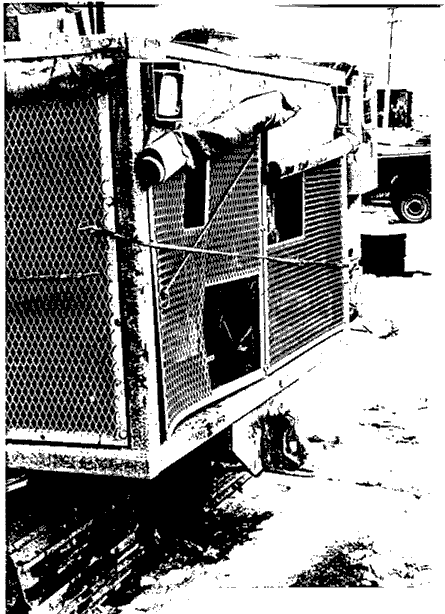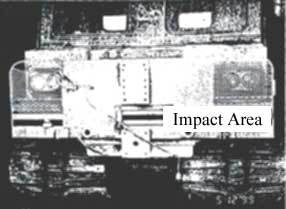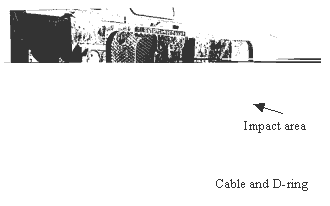Drill Operator Crushed Between Drill Rig and Transport Vehicle
Alaska FACE Investigation 99AK012
February 14, 2000
SUMMARY
A drill rig operator was killed while trying to attach a cable from another vehicle to the back of his drill rig. The drill rig was stuck in the snow, and a co-worker driving a transport vehicle stopped to help. In order to pull out the rig, the drivers attempted to attach a cable on the front of the transport vehicle to a hook on the back of the rig. The co-worker positioned the transport vehicle behind the rig; the vehicles were aligned with the left front of the transport vehicle slightly to the outside of the left rear corner of the rig. Due to a slight grade in the road and slackness of the tracks, the transport vehicle tended to slide back when it was stopped. The victim stood between the vehicles to fasten the cable onto the hook. Two attempts were made to attach the cable; each time the victim jumped from between the vehicles as the transport vehicle moved close to the rig. On the third attempt, the victim was caught between the vehicles. His co-worker moved the transport vehicle away from the rig and flagged a co-worker. They pulled the victim from between the vehicles and checked his injuries. The victim briefly regained consciousness, spoke to his two co-workers, and then collapsed again. Upon the arrival of more co-workers, CPR was initiated, and one person was sent to a truck with a two-way radio to notify Emergency Medical Services (EMS). The victim was placed on a sled behind a snowmachine and towed to the truck. Before EMS technicians arrived, the victim was transferred to the truck and driven to a nearby medical facility. He was pronounced dead on arrival.
Based on the findings of the investigation, to prevent similar occurrences, employers should:
- Ensure that workers are able to recognize and avoid hazardous situations and develop and implement a driver training program that includes, but is not limited to, snow travel and techniques for assisting stuck vehicles;
- Ensure that a written and comprehensive safety program covers all work practices performed by employees;
- Ensure that workers follow all prescribed work practices for transporting equipment and supplies and enforce a comprehensive safety program.
INTRODUCTION
At approximately 9:30 p.m. on May 8, 1999, a 38-year old male driller (the victim) was crushed when he was caught between a mobile drill rig and a transport vehicle. On May 12, 1999, the Alaska Department of Labor (AKDOL) notified the Alaska Division of Public Health, Section of Epidemiology. An investigation involving an injury prevention specialist for the Alaska Department of Health and Social Services, Section of Epidemiology ensued on June 1, 1999. Since the company had removed its equipment from the area, a site visit was not conducted. The incident was reviewed with the AKDOL investigating official. An employer interview was conducted by telephone. Alaska State Trooper, Medical Examiner, and AKDOL reports and photographs were requested.
The company involved in this incident was privately owned and had been in business for more than 8 years. At the time of the incident, it was contracted to provide drilling and processing services for an exploration company (the contractor). The company had four employees, including three drill operators and one drilling helper. The victim was employed as a drill operator and had worked with the company for 8 years. In addition, the contractor hired a drilling helper (the witness) who was trained on-the-job to operate the transport rig. He had worked with the company for 3 weeks.
The company had a written safety program that was approved by MSHA in 1995. The safety program included machinery operation, drilling practices, and employee conduct at work sites. Motor vehicle or transportation safety training was not provided. The track vehicles did not have two-way radios. All company employees were first aid and CPR certified. Safety meetings were conducted weekly and as needed.
INVESTIGATION
The incident occurred at a remote site in western Alaska. Employees had completed a series of drilling assignments and were transporting equipment and supplies back to a staging area. The terrain along an access road from the drilling site was semi-flat with some slight grades. The road consisted of 1-2 feet of soft snow on top of hard-packed snow base. The areas bordering the access road were covered with 5-6 feet of unpacked snow. Weather was not considered to be a contributing factor in this incident. Although the event took place in the evening hours, there was still considerable daylight at the time of the event.
On the day of the incident, the victim was leading a group of vehicles and snowmachines back to the company staging area. All vehicles, including the mobile drill rig, were track-mounted. The drill rig driven by the victim was followed by a transport vehicle driven by a co-worker (the witness). The transport vehicle had wide tracks and was capable of pulling other vehicles if they became stuck. A third vehicle, a transport vehicle towing a compressor unit, was approximately ¼ mile behind the first two and contained chains and other gear to be used to help extract a stuck vehicle.
The drill rig and the rear transport vehicle were owned by the company, however the middle vehicle was leased by the contractor from a local mineral exploration company. The three vehicles were two-tracked (having body-length track on both sides). Deck height (from the ground) was approximately 40 inches. The drill rig had a front operator’s compartment and an engine in the rear of the unit. The housing around the engine compartment consisted of a steel frame with steel mesh panels. A pintle hook was attached to the rear of the frame rail (Figure 1).

Figure 1. Impact area on engine compartment door of drill rig, viewed from rear left side.
The first transport vehicle had a cab for the operator and passenger(s) over an engine that was located at the front of the unit. A debris guard was mounted to the frame in front of the engine. The guard had a central panel of heavy gauge steel with steel mesh panels in front of each headlight. A wire rope or cable was attached at two points (approximately 26 inches apart) to the vehicle frame rail under the debris guard (Figure 2a and b). The cable was approximately 8 feet long and was threaded through a D-ring. When pulled taut at the center away from the front of the vehicle, the cable formed a V-shape with a total clearance of 40 inches.
As the vehicles moved along the access road, the front part of the right track of the drill rig went off the road into the snow and became stuck. The driver tried to free the rig by rocking it back and forth, but it remained stuck. The drill rig driver and the transport vehicle driver decided to attach the cable on the transport vehicle to the pintle hook on the drill rig and use the transport vehicle to pull the rig back onto the road. This had been done previously.

|

|
| Figure 2a. Impact area on debris guard transport vehicle. | Figure 2b. Cable and D-ring attached to transport vehicle, viewed from front passenger side. |
The two vehicles were oriented at an approximate 10° angle and aligned with the left front of the transport vehicle behind and slightly to the left of the left rear corner of the rig (Figure 3). As the witness moved the transport vehicle forward, the right side of the transport rig was behind the left side of the drill rig.

Figure 3. Aerial view of drill rig and transport vehicle (Not to scale)
The victim was standing between the vehicles directing the witness and trying to attach the D-ring to the pintle hook. On the first attempt, the witness moved the transport vehicle close to the rear of the drill rig and put on the brakes. The victim tried to attach the cable to the drill rig but was unable to connect the vehicles. Due to a slight slope and slackness of the tracks when the transport vehicle was stopped it rolled away from the drill rig. A second attempt was made; this time the victim instructed the witness to place the vehicle in neutral when stopping. The second attempt was unsuccessful. During both the first and second attempts, the victim jumped from between the vehicles towards the center of the road to avoid being crushed. On the third attempt, the victim again positioned himself between the two vehicles as the witness inched the transport vehicle forward. The victim was crushed between the two vehicles.
The witness made two attempts to place the transport vehicle in reverse gear before he was able to move it back. He got out of his vehicle and went to the victim. The victim was unconscious on the ground, half under the drill rig. By this time, the third track vehicle arrived, and the witness flagged the driver to stop. They pulled the victim from between the vehicles. The victim briefly regained consciousness, spoke a few words, and collapsed again. The other crew members on snowmachines arrived at the incident site and CPR was initiated. A co-worker was sent to a community road where two employees of the contractor were located. They used a two-way radio in their truck to contact emergency medical services (EMS). The victim was not responding to CPR. He was moved to a sled and transported behind a snowmachine to the community road, arriving at the truck shortly after the call to EMS. The victim was transferred to the truck and driven to a nearby medical center where he was pronounced dead on arrival.
CAUSE OF DEATH
The medical examiner’s report listed the cause of death as massive crush injury.
RECOMMENDATION/DISCUSSION
Recommendation #1: Employers should ensure that workers are able to recognize and avoid hazardous situations and should develop and implement a driver training program that includes, but is not limited to, snow travel and techniques for assisting stuck vehicles.
Discussion: In this case, the victim placed himself between two vehicles while attempting to connect them with a cable. Knowing the driver needed to move the transport vehicle, he placed himself in an extremely hazardous position. Workers should always assume the area surrounding vehicles or equipment is hazardous, particularly when activities are between two vehicles. Vehicles should be positioned, the brake set, and the engine turned off before workers go between vehicles. Workers should be instructed to follow all company work practices and use equipment and supplies designated for the safe and efficient accomplishment of their task(s).
Recommendation #2: Employers should ensure that a written and comprehensive safety program covers all work practices performed by employees.
Discussion: The employer had a written safety program that covered operations and tasks of drilling, collecting and processing samples. However, driving rigs and equipment to and from a work site was not addressed. Employers should review all tasks performed by employees and provide training as needed to ensure safe practices. Driver training should include, but not be limited to, :
- Tracked vehicle response on different types of terrain
- Assessing stability of a tracked vehicle and materials loaded on the unit or in tow
- Proper use of equipment to safeguard against personal injury
- Common problems and solutions during travel
- Safety procedures for stuck vehicles including the correct placement of hooks and cables
Training should be documented in the employee record and include training dates, completion verification, and course content (checklist).
Recommendation #3: Employers should ensure that workers follow all prescribed work practices for transporting equipment and supplies and enforce a comprehensive safety program.
Discussion: In this incident, the victim did not follow prescribed work practices that required workers to use designated equipment (including straps, cables, and chains) and procedures to pull stuck vehicles. The equipment and procedures should be reviewed with employees prior to relocating to a work site and whenever necessary to promote the safe and efficient accomplish of a task. Employers should consider conducting random work site safety inspections and supervisor observations to evaluate compliance with and understanding of established safety standards and practices. While employees have the right to question the safety of any task, they are responsible for following the practices outlined by their employers safety program. In addition to specific safe practices, steps should be outlined and discussed with employees for noncompliance with an established safety program.
Fatality Assessment and Control Evaluation (FACE) Project
The Alaska Division of Public Health, Section of Epidemiology performs Fatality Assessment and Control Evaluation (FACE) investigations through a cooperative agreement with the National Institute for Occupational Safety and Health (NIOSH), Division of Safety Research (DSR). The goal of these evaluations is to prevent fatal work injuries in the future by studying the working environment, the worker, the task the worker was performing, the tools the worker was using, the energy exchange resulting in fatal injury, and the role of management in controlling how these factors interact.
To contact Alaska State FACE program personnel regarding State-based FACE reports, please use information listed on the Contact Sheet on the NIOSH FACE web site Please contact In-house FACE program personnel regarding In-house FACE reports and to gain assistance when State-FACE program personnel cannot be reached.
